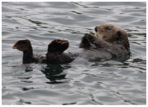IER Transportation Plan For Moving off Oil
We need to get away from the use of oil in transportation. The problem is far worse than the fear that we may run out of oil. Although this has grabbed the headlines for four decades, it has buried even bigger issues. Issues such as what gasoline and diesel are doing to our health. Such as what these fuels are doing to our earth's environment. Such as what the high price of oil has mean't for our paychecks not being able to buy what they used to. And, definitely not to be ignored, how much we pay to keep the oil flowing. We start to inform you by stating our Vision, Goal and Agenda (below), and summarize our 6 pronged approach to implementing these in the right sidebar.
To get an idea of the factors we think are important to preserve, ones that take our enjoyment and desires into account go to Americas Transportation Needs and Considerations. These form the basis from which the Vision, Goal and Agenda spring forth. There you can find a more detailed discussion of the mission of IER.
IER's VISION FOR TRANSPORTATION:
We will present a Plan that smoothly moves to using alcohols in our IC engines, which are made from corn and fossil natural gas, to using methanol and ethanol made from organic wastes, waste water or "'brackish water" to purpose grown algae and CO2. Along the way we will have energy sources consisting of mixtures of fossil natural gas and renewable biogas. Initially the ethanol and methanol will fuel the classical Internal Combustion Engine (ICE), but in later stages methanol will fuel Direct Methanol Fuel Cells, and possibly PEM fuel cells, and further down the road Solid Oxide Fuel Cells (SOFC). See Executive Summary of Plan.
IER's TRANSPORTATION GOAL:
IER’s goal is to get States and cities to work together with methanol and ethanol suppliers at first using imported methanol, but soon transitioning to methanol/ethanol made from domestic natural gas. As soon as possible to modify and/or certify existing Flex Fueled vehicles to be able to use methanol. As soon as possible begin the manufacture of 3-fuel flex fuel vehicles, ones that can use any fraction of gasoline, ethanol or methanol. As methanol plants using fossil natural gas come on-line, renewable bio-natural gas needs to be blended in the mixture, making the resulting methanol/ethanol increasingly greener and renewable.
IER’s TRANSPORTATION AGENDA:
1. Begin educating government entities, politicians, municipalities, farms and industry about the value of using alcohols (methanol and ethanol) and about the fact that they will ultimately be made so as to be very low in net carbon. For example, they can be made renewably from bio-methane via anaerobic digestion of our organic wastes, and perhaps purpose grown organics, such as algae.
2. Encourage Federal legislation, such as the Open Fuels Standards Act, so that methanol, as well as ethanol, can be used in our vehicles.
3. Encourage the use of Blender pumps so that optimal alcohol blends can be used - these are different for different vehicle models. But once determined, the optimum blend can be dialed in by the consumer for regulate use.
4. To encourage federal, state and local tax incentives to promote the manufacture of renewable natural gas and its mixture by natural gas distribution companies into fossil natural gas that can be sent to methanol plants.
5. To encourage auto manufacturers to produce light as well as heavy duty vehicles that can use alcohols (especially methanol).
6. After maximizing the production of renewable natural gas from anaerobic digestion of societal wastes, integrate this gas production with the production of renewable natural gas from algae, the fastest growing vegetable on earth, so we can increase the proportion of renewable natural gas in the methanol and the ethanol we make.
Further details are here.
Return to CARB wheel to well emissions.

